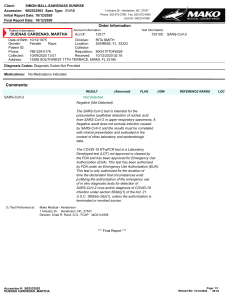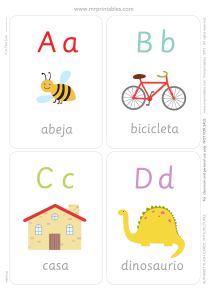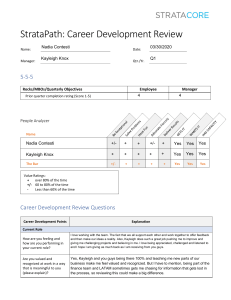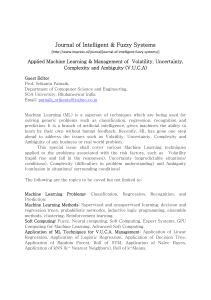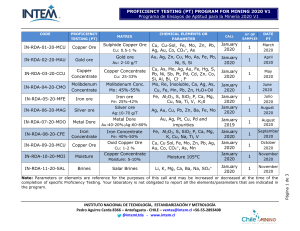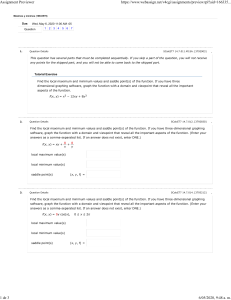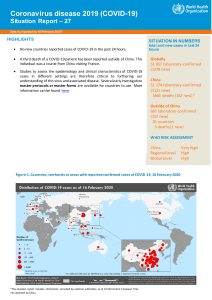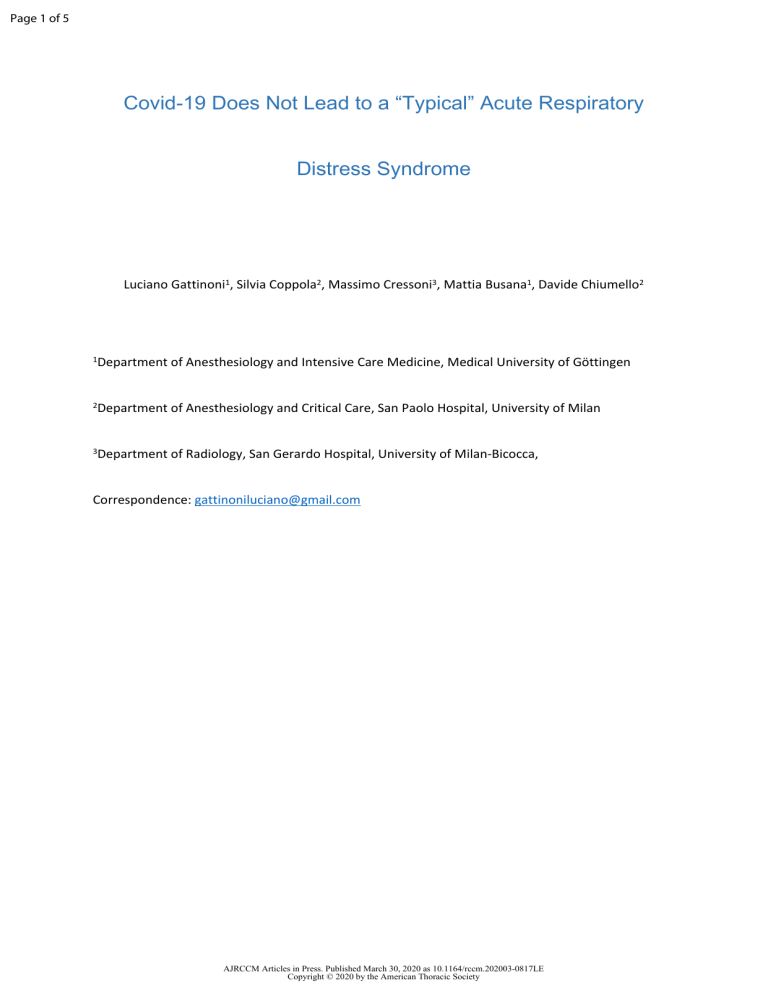
Page 1 of 5 Covid-19 Does Not Lead to a “Typical” Acute Respiratory Distress Syndrome Luciano Gattinoni1, Silvia Coppola2, Massimo Cressoni3, Mattia Busana1, Davide Chiumello2 1Department of Anesthesiology and Intensive Care Medicine, Medical University of Göttingen 2Department of Anesthesiology and Critical Care, San Paolo Hospital, University of Milan 3Department of Radiology, San Gerardo Hospital, University of Milan-Bicocca, Correspondence: [email protected] AJRCCM Articles in Press. Published March 30, 2020 as 10.1164/rccm.202003-0817LE Copyright © 2020 by the American Thoracic Society Page 2 of 5 Dear Editor, In northern Italy an overwhelming number of patients with Covid-19 pneumonia and acute respiratory failure have been admitted to our Intensive Care Units. Attention is primarily focused on increasing the number of beds, ventilators and intensivists brought to bear on the problem, while the clinical approach to these patients is the one typically applied to severe ARDS, namely high Positive End Expiratory Pressure (PEEP) and prone positioning. However, the patients with Covid-19 pneumonia, fulfilling the Berlin criteria of ARDS, present an atypical form of the syndrome. Indeed, the primary characteristics we are observing (confirmed by colleagues in other hospitals), is the dissociation between their relatively well preserved lung mechanics and the severity of hypoxemia. As shown in our first 16 patients (Figure 1), the respiratory system compliance of 50.2 ± 14.3 ml/cmH2O is associated with shunt fraction of 0.50 ± 0.11. Such a wide discrepancy is virtually never seen in most forms of ARDS. Relatively high compliance indicates well preserved lung gas volume in this patient cohort, in sharp contrast to expectations for severe ARDS. A possible explanation for such severe hypoxemia occurring in compliant lungs is the loss of lung perfusion regulation and hypoxic vasoconstriction. Actually, in ARDS, the ratio between the shunt fraction to the fraction of gasless tissue is highly variable, with mean 1.25 ± 0.80(1). In eight of our patients with CT scan, however, we measured a ratio of 3.0 ± 2.1, suggesting remarkable hyperperfusion of gasless tissue. If so, the oxygenation increases with high PEEP and/or prone position are not primarily due to recruitment, the usual mechanism in ARDS(2), but instead, in these patients with a poorly recruitable pneumonia(3), to the redistribution of perfusion in response to pressure and/or gravitational forces. We should consider that: 1. Patients treated with Continuous Positive Airway Pressure or Non Invasive Ventilation, presenting with clinical signs of excessive inspiratory efforts, intubation should be prioritized to avoid excessive intrathoracic negative pressures and self-inflicted lung injury(4). AJRCCM Articles in Press. Published March 30, 2020 as 10.1164/rccm.202003-0817LE Copyright © 2020 by the American Thoracic Society Page 3 of 5 2. High PEEP in a poorly recruitable lung tends to result in severe hemodynamic impairment and fluid retention; 3. Prone positioning of patients with relatively high compliance results in a modest benefit at the price of a high demand for stressed human resources. After considering that, all we can do ventilating these patients is “buying time” with minimum additional damage: the lowest possible PEEP and gentle ventilation. We need to be patient. AJRCCM Articles in Press. Published March 30, 2020 as 10.1164/rccm.202003-0817LE Copyright © 2020 by the American Thoracic Society Page 4 of 5 Bibliography 1. Cressoni M, Caironi P, Polli F, Carlesso E, Chiumello D, Cadringher P, Quintel M, Ranieri VM, Bugedo G, Gattinoni L. Anatomical and functional intrapulmonary shunt in acute respiratory distress syndrome. Critical care medicine 2008. 2. Gattinoni L, Caironi P, Cressoni M, Chiumello D, Ranieri VM, Quintel M, Russo S, Patroniti N, Cornejo R, Bugedo G. Lung recruitment in patients with the acute respiratory distress syndrome. N Engl J Med 2006; 354: 1775-1786. 3. Pan C, Chen L, Lu C, Zhang W, Xia JA, Sklar MC, Du B, Brochard L, Qiu H. Lung Recruitability in SARSCoV-2 Associated Acute Respiratory Distress Syndrome: A Single-center, Observational Study. Am J Respir Crit Care Med 2020. 4. Brochard L, Slutsky A, Pesenti A. Mechanical Ventilation to Minimize Progression of Lung Injury in Acute Respiratory Failure. Am J Respir Crit Care Med 2017; 195: 438-442. AJRCCM Articles in Press. Published March 30, 2020 as 10.1164/rccm.202003-0817LE Copyright © 2020 by the American Thoracic Society Page 5 of 5 Figure 1 304x152mm (300 x 300 DPI) AJRCCM Articles in Press. Published March 30, 2020 as 10.1164/rccm.202003-0817LE Copyright © 2020 by the American Thoracic Society

